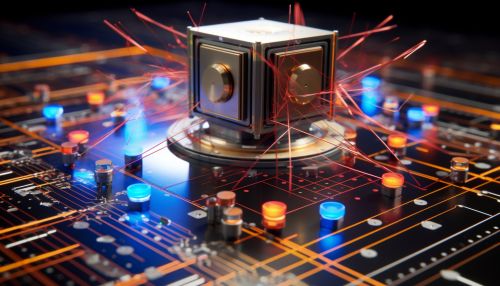Quantum Annealing in Optimization Problems
Quantum Annealing
Quantum annealing (QA) is a metaheuristic for finding the global minimum of a given objective function over a given set of candidate solutions. It is a quantum analog of simulated annealing, where thermal fluctuations are replaced by quantum fluctuations. Quantum annealing is used mainly for problems where the search space is discrete with many local minima; such as finding the ground state of a physical system.


Quantum Mechanics and Quantum Computing
Quantum annealing relies on quantum mechanics, which describes nature at the smallest scales of energy levels of atoms and subatomic particles. Quantum mechanics introduces the concept of quantum superposition, which allows a particle to be in multiple states at once, and quantum entanglement, which allows particles to instantaneously affect each other regardless of distance.
Quantum computing uses these principles to process information. A quantum computer maintains a sequence of qubits. A single qubit can represent a one, a zero, or any quantum superposition of those two qubit states. A pair of qubits can be in any quantum superposition of 4 states, and three qubits in any superposition of 8 states. In general, a quantum computer with n qubits can be in an arbitrary superposition of up to 2^n different states simultaneously.
Quantum Annealing Process
Quantum annealing starts from a quantum-mechanical superposition of all possible states (configurations) with equal weights. Then the system evolves following the time-dependent Schrödinger equation, a fundamental equation in quantum mechanics. The amplitudes of all candidate states keep changing, realizing a quantum parallelism, and finally, the system transits to the desired states that correspond to the optimal solutions.
The annealing process involves slowly varying a parameter in the system Hamiltonian. In the beginning, the Hamiltonian is set in a way that the ground state corresponds to a uniform superposition of all possible solutions. This initial Hamiltonian is easy to prepare. The final Hamiltonian encodes the optimization problem to be solved. The system is cooled down slowly enough that it remains in the ground state of the instantaneous Hamiltonian if it started in the ground state of the initial Hamiltonian.
Quantum Annealing in Optimization Problems
Quantum annealing is particularly suitable for solving optimization problems. An optimization problem seeks to find the best solution from all feasible solutions. In many complex systems, the number of feasible solutions grows exponentially with the size of the system, and finding the optimal solution becomes intractable with classical computers.
Quantum annealing, with its ability to maintain superposition of states, provides a way to traverse the solution landscape efficiently. It uses quantum fluctuations to escape local minima and has the potential to find the global minimum more efficiently than classical algorithms.
Quantum Annealing Machines
Quantum annealing machines, such as the D-Wave system, have been developed to implement quantum annealing algorithm. These machines use superconducting circuits as artificial atoms (qubits) to encode the problem. The D-Wave system is designed to solve a particular kind of problem known as Quadratic Unconstrained Binary Optimization (QUBO).
Limitations and Challenges
Despite its potential, quantum annealing faces several challenges. The quality of solutions depends on the annealing time and the specific implementation of the annealing process. It is also sensitive to noise and requires error correction. Moreover, current quantum annealing machines can only solve specific types of problems and are limited by the number of qubits and connectivity between qubits.
Future Directions
Research is ongoing to overcome the limitations of quantum annealing and to find new applications. Quantum annealing could potentially be applied to a wide range of problems, from logistics and finance to machine learning and artificial intelligence.
